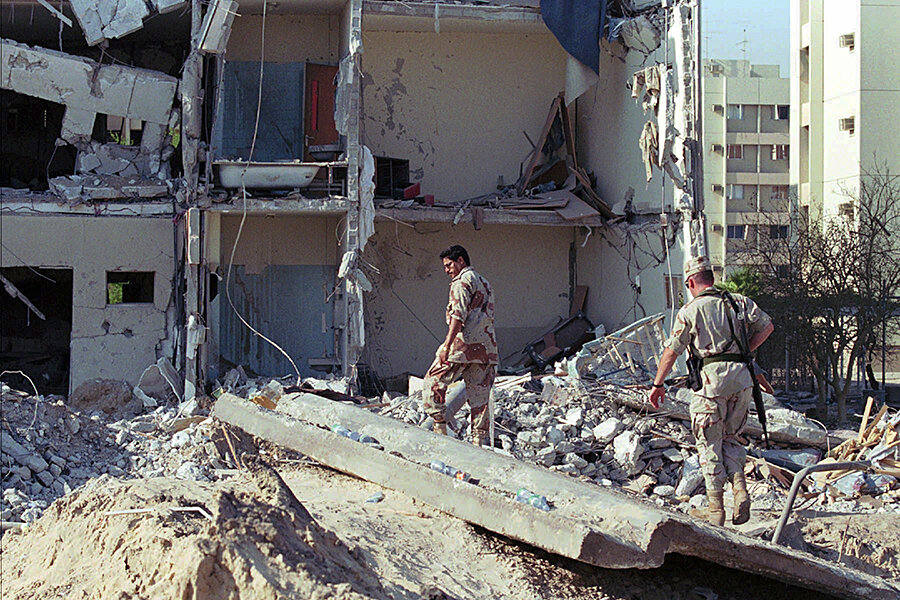Did Saudis nab mastermind of 1996 terror attack on US forces?
Loading...
| Beirut, Lebanon
The reported arrest and handover of the accused architect of a 1996 terror attack in Saudi Arabia that killed 19 US servicemen has been met with official silence here, one day after a Saudi newspaper broke the news.
If confirmed, the arrest of Ahmad Mughassil, military commander of the Iranian-backed Saudi Hezbollah organization believed to be behind the bombing, would be a coup for the Saudi government and the FBI, which had offered a $5 million reward for his capture. Ash Sharq al-Awsat, the Saudi newspaper, said he had been sent to a US military base in Saudi Arabia.
Lebanon’s Al Akhbar newspaper, a pro-Hezbollah outlet, today provided some corroboration. It said the intelligence branch of Lebanon’s Internal Security Forces had “kidnapped” Mr. Mughassil upon his arrival at Beirut airport and handed him over to the “kingdom of petrol.”
“It was [the Saudi] intelligence services that had informed the information branch of the date of Mughassil’s arrival, based on US information,” Al Akhbar said. Saudi Hezbollah also denounced Mughassil’s arrest as a “treacherous action.”
Given the links between Lebanon’s Hezbollah and its Saudi counterpart, it remains to be seen if there will be any further backlash in Beirut. So far Iran-backed Hezbollah, a powerful player in Lebanon's sectarian-rooted politics, has withheld comment.
The Associated Press quoted an unidentified Saudi official as saying Mughassil, a Shiite from Qatif in eastern Saudi Arabia, was arrested two weeks ago in Beirut after having arrived from Iran. Mughassil was attempting to reach the Hezbollah-dominated southern suburbs of Beirut when he was detained, the official told AP.
“The discovery of Mughassil and his arrest in Lebanon and his subsequent transfer to Saudi Arabia is a qualitative achievement, for the man had been in disguise in a way that made it hard to identify him,” the Saudi newspaper said without adding further details.
Deadliest attack in over a decade
The FBI accuses Mughassil of plotting the June 1996 tanker truck bomb explosion targeting the Khobar Towers complex in Dhahran used by American, British, French, and Saudi military personnel. In addition to the 19 killed US servicemen, another 372 people were wounded in the huge blast, the deadliest against American troops since the 1983 US Marine barracks bombing in Beirut.
According to Matt Levitt, a counter-terrorism and intelligence specialist with the Washington Institute for Near East Policy, Mughassil was living in Beirut prior to the 1996 attack. “He basically ran the Khobar operation – directing surveillance, providing funds, arranging for the explosives to be driven from Lebanon – from his Beirut apartment,” Mr. Levitt says.
Mughassil's presence in Beirut suggests he had the protection of Lebanese Hezbollah, which makes his arrest all the more curious considering its influence here.
Iran is reportedly the principal backer of Saudi Hezbollah, also known as Hezbollah al-Hijaz, as well as its powerful Lebanese counterpart. A 2001 federal indictment, which accused Mughassil and 12 other Saudi Hezbollah members of carrying out the Khobar Towers bombing, provided details of the alleged links between Iran and the Saudi and Lebanese branches of Hezbollah.
Most of the 13 Saudis were said to have received military training in Hezbollah camps in Lebanon or in Iran. An unidentified 14th individual, named as “John Doe” in the indictment, was said to be a Lebanese member of Hezbollah who helped construct the truck bomb at a farm near Qatif in Saudi Arabia.
Iran has always denied any involvement in the Khobar Towers bombing, blaming Al Qaeda for the attack.







